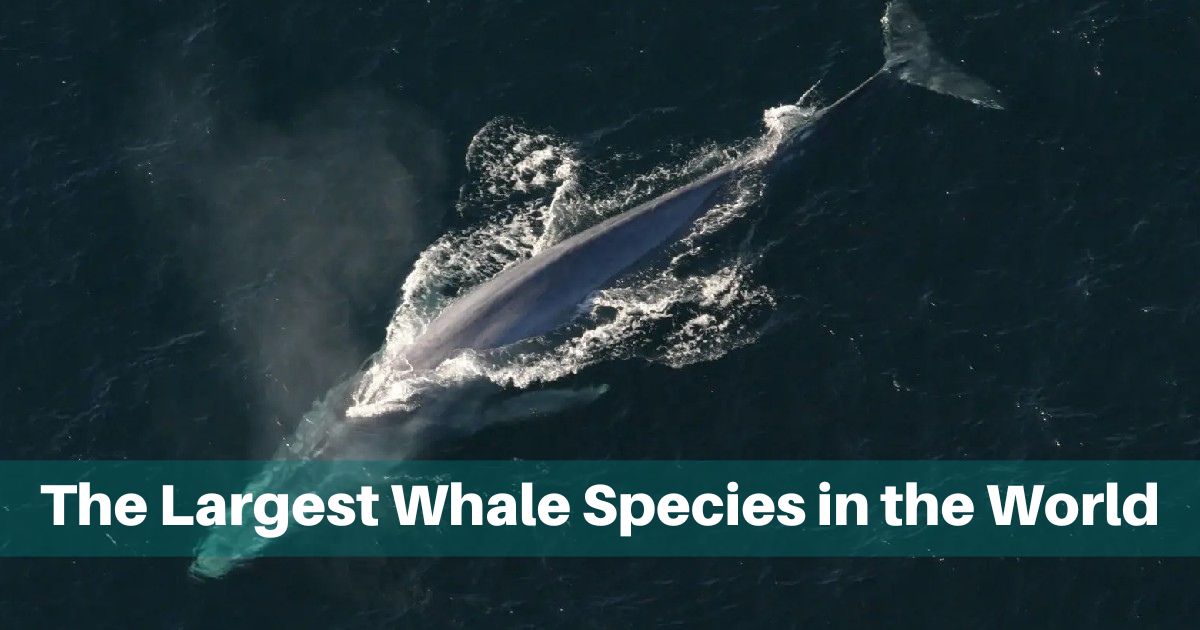Whales, the titans of the ocean, have fascinated humans for centuries. These majestic creatures play vital roles in marine ecosystems and captivate us with their sheer size and incredible behaviors. This article delves into the largest whale species, highlighting their dimensions, unique features, and fascinating characteristics. We will explore both mysticetes (baleen whales) and odontocetes (toothed whales), showcasing the diversity and grandeur of these marine mammals.
I. Mysticetes (Baleen Whales)
Mysticetes, or baleen whales, are a suborder of cetaceans characterized by baleen plates instead of teeth, which they use to filter feed on small organisms like krill and plankton. These whales are typically larger than toothed whales, with species like the blue whale, the largest animal on Earth, falling under this category. Baleen whales include well-known species such as humpback whales, right whales, and fin whales, each playing crucial roles in marine ecosystems.
Humpback Whale
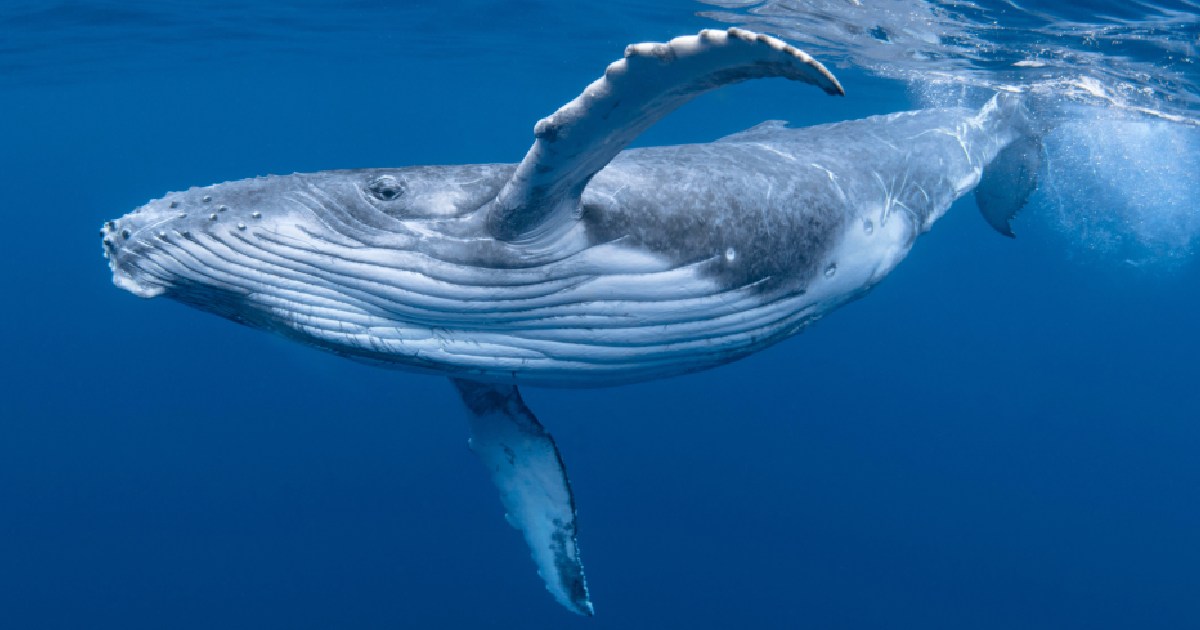
- Size: Over 50 feet (15 meters), up to 40 US tons (36 metric tonnes)
- Scientific Name: Megaptera novaeangliae
- Key Feature: Long pectoral fins
Humpback whales are celebrated for their acrobatic displays and charismatic nature, often becoming the highlight of many whale-watching tours. These baleen whales can grow to over 50 feet in length and weigh more than 40 tons. Their scientific name, Megaptera novaeangliae, translates to “big-winged New Englander,” referring to their long pectoral fins, which are the longest of any whale species, comprising one-third of their body length.
Humpback whales are easily recognized by their knobby heads and unique tail flukes, which feature black and white patterns that help researchers identify individuals. These whales are known for their complex songs, which can be heard over vast distances underwater. Each population of humpbacks has its own distinct song, which changes slightly every year, adding to their allure. Their migratory patterns take them from the warm tropical waters, where they breed and give birth, to the nutrient-rich polar waters, where they feed during the summer months.
Blue Whale
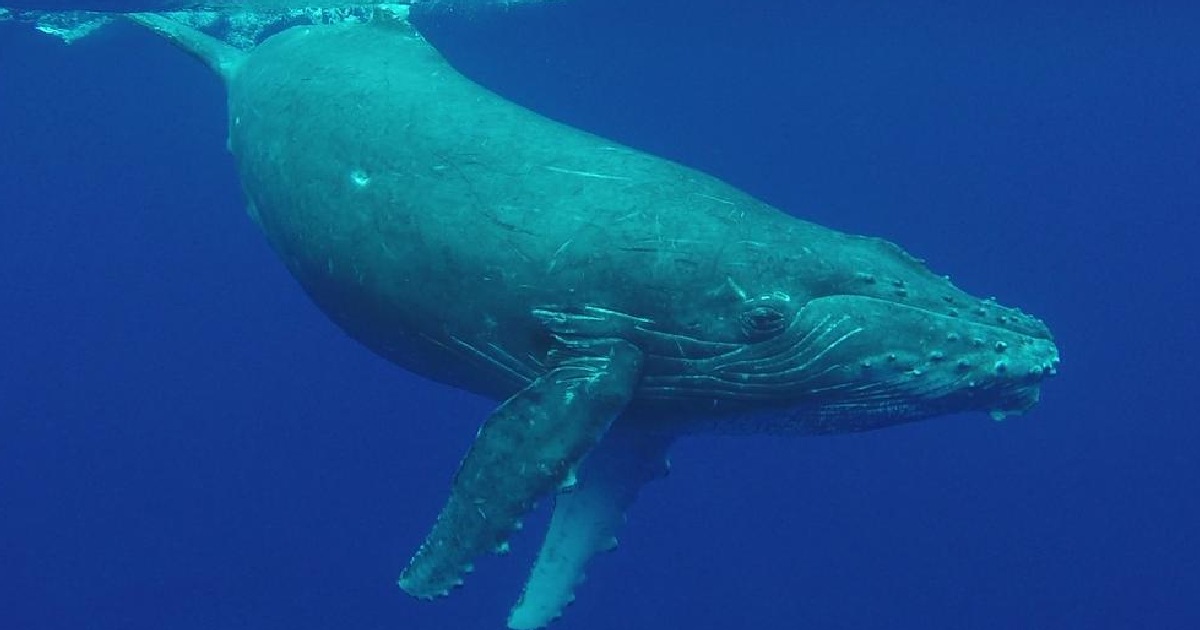
- Size: Up to 100 feet (30 meters), up to 100 US tons (90 metric tonnes)
- Scientific Name: Balaenoptera musculus
- Key Feature: Largest animal on Earth
The blue whale holds the title of the largest animal ever known to have lived on Earth. These colossal baleen whales can reach lengths of up to 100 feet and weigh as much as 100 tons. Their tongues alone can weigh as much as an elephant. Blue whales have a sleek, streamlined body that appears bright blue underwater, giving them their name.
In addition to their size, blue whales are also the loudest animals on the planet. Their low-frequency vocalizations can be as loud as a jet engine and travel hundreds of miles underwater. Despite their size, blue whales feed primarily on tiny krill, consuming up to four tons of these small crustaceans daily during feeding season. The sight of a blue whale calf, already sizable at birth, nursing next to its massive mother, is a testament to the grandeur of these ocean giants. Blue whales are often found in the Southern Ocean and migrate to warmer waters for breeding.
Right Whale

- Size: Up to 50 feet (15 meters), up to 70 US tons (63 metric tonnes)
- Scientific Name: Eubalaena spp.
- Key Feature: Unique callosities on the head
Right whales, including the North Atlantic right whale (Eubalaena glacialis), are among the most endangered whale species. Named by whalers as the “right” whale to hunt due to their slow speed and high blubber content, right whales were hunted nearly to extinction. They can grow up to 50 feet in length and weigh up to 70 tons. Their distinctive callosities—rough, white patches of skin on their heads—are unique to each individual and are used by researchers for identification.
This type of baleen whale is also known for their lack of a dorsal fin and their broad, paddle-like flippers. Right whales produce a characteristic V-shaped blow when they breathe. Despite being protected by international law, they face significant threats from entanglement in fishing gear, vessel strikes, and underwater noise pollution, particularly in the busy waters of the North Atlantic. Conservation efforts focus on mitigating these threats to protect the remaining populations.
Fin Whale
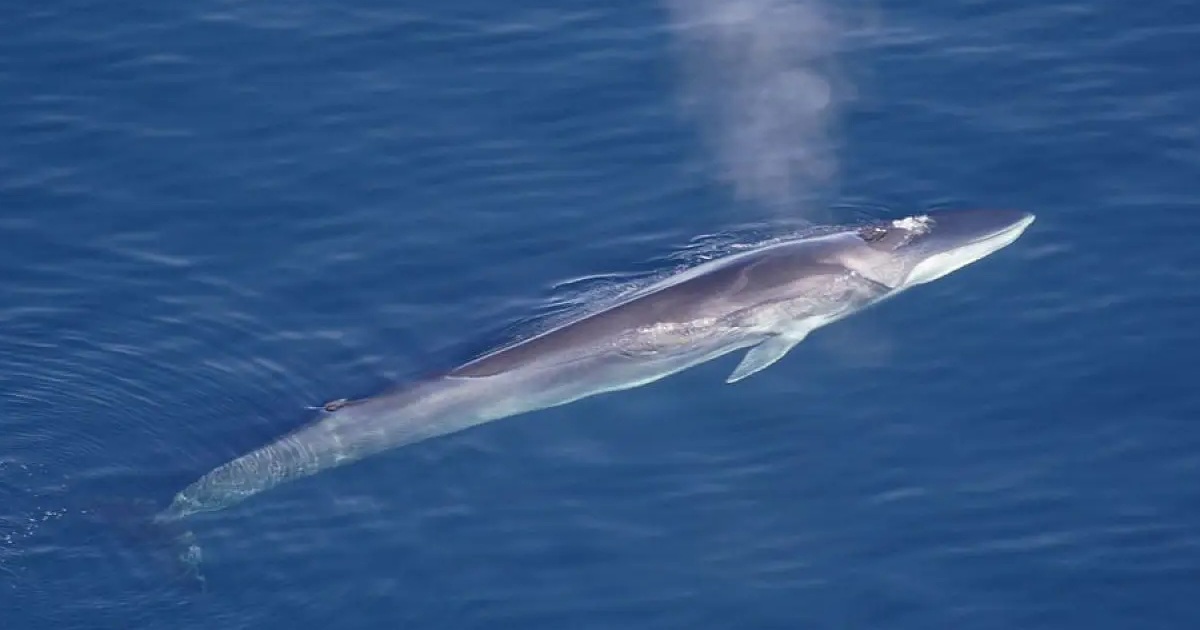
- Size: Up to 80 feet (24 meters), up to 70 US tons (63 metric tonnes)
- Scientific Name: Balaenoptera physalus
- Key Feature: Prominent dorsal fin and asymmetrical jaw coloration
Fin whales are the second largest animal on Earth, next to blue whales. These sleek, fast swimmers can reach lengths of up to 80 feet and weigh as much as 70 tons. Known as the “greyhounds of the sea,” fin whales are among the fastest of the large whales. They belong to the rorqual family, which includes blue whales and humpback whales, characterized by their pleated throats that expand to consume large quantities of water and prey.
Fin whales have a distinctive asymmetrical coloration on their jaws—the lower right jaw is white, while the left is dark. This unique feature is believed to aid them in hunting. Despite their size, fin whales remain vulnerable to whaling, particularly in regions like Iceland. Conservation efforts are crucial to ensuring the survival of these majestic marine giants. They are commonly found in both the Northern and Southern Hemispheres and migrate seasonally between feeding and breeding grounds.
II. Odontocetes (Toothed Whales)
Odontocetes, or toothed whales, are a suborder of cetaceans distinguished by their teeth, which they use to catch and eat larger prey such as fish and squid. This group includes species like the sperm whale, which is the largest-toothed predator, and the highly social and intelligent orca, or killer whale. Toothed whales rely on echolocation to navigate and hunt in the ocean’s depths, showcasing their advanced sensory capabilities.
Sperm Whale

- Size: Up to 60 feet (18 meters), up to 45 US tons (40 metric tonnes)
- Scientific Name: Physeter macrocephalus
- Key Feature: Largest-toothed predator with a massive, blunt head
Sperm whales are the largest of the toothed whales and the world’s largest toothed predators. They can grow up to 60 feet in length and weigh up to 45 tons. Sperm whales are easily recognized by their large, blunt heads and small jaws. Their heads house a spermaceti organ, filled with a waxy substance once highly valued in the whaling industry for use in candles and oil lamps.
These deep-diving giants can descend to depths of over 6,000 feet, holding their breath for more than an hour as they hunt for their primary prey, giant squid. Sperm whales use echolocation clicks and pulses to navigate and locate prey in the dark depths of the ocean. Despite their historical exploitation, sperm whales continue to inspire awe with their formidable presence and deep-diving capabilities. Their social structure is matriarchal, with females and their young living in groups while males often roam solitary.
Orca
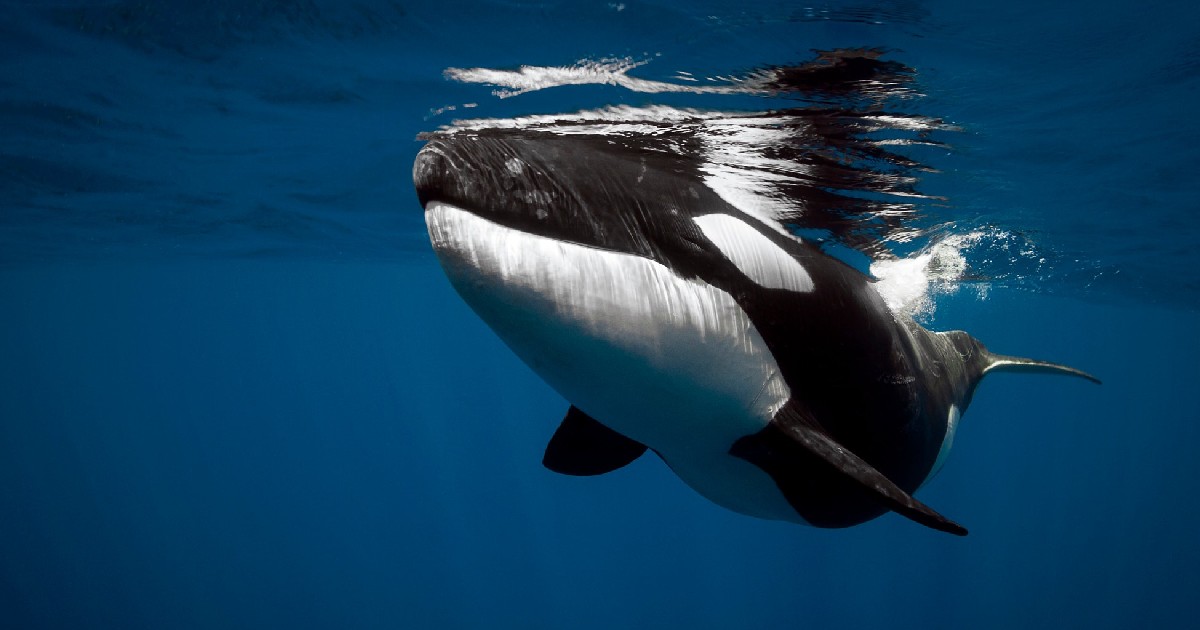
- Size: Up to 32 feet (9 meters), up to 9 metric tonnes (8 US tons)
- Scientific Name: Orcinus orca
- Key Feature: Distinct black and white coloration
Orcas, or killer whales, are one of the most recognizable marine mammals, known for their striking black-and-white coloration. Technically, the largest members of the dolphin family, male orcas, can grow up to 32 feet in length and weigh up to 9 tons. Orcas are apex predators, often referred to as the “wolves of the sea” due to their complex hunting strategies and social structures.
Highly intelligent and social, orcas live in matriarchal pods and exhibit sophisticated communication skills. They are known for their coordinated hunting techniques, which vary by region and prey type. These adaptable predators can be found in oceans worldwide, from the Arctic to the Antarctic, showcasing their incredible adaptability and intelligence. Their diet is diverse, ranging from fish and squid to seals and even other whales.
Beluga Whale

- Size: Up to 15 feet (4.5 meters), up to 1.5 US tons (1.3 metric tonnes)
- Scientific Name: Delphinapterus leucas
- Key Feature: Uniform white color and vocalizations
Beluga whales, often called “sea canaries” due to their high-pitched vocalizations, are found in the Arctic and sub-Arctic regions. They grow up to 15 feet in length and weigh up to 1.5 tons. Belugas are easily identified by their uniform white color, which provides camouflage in icy environments. They have a rounded head with a prominent forehead, known as the melon, used for echolocation.
Belugas are highly social and vocal, communicating with a variety of sounds. They are well-adapted to their cold environments, with a thick layer of blubber for insulation. These whales are culturally significant to indigenous Arctic communities and are a vital part of the Arctic marine ecosystem. Belugas often inhabit shallow coastal waters and river mouths, making them one of the most accessible whale species for observation.
Bowhead Whale
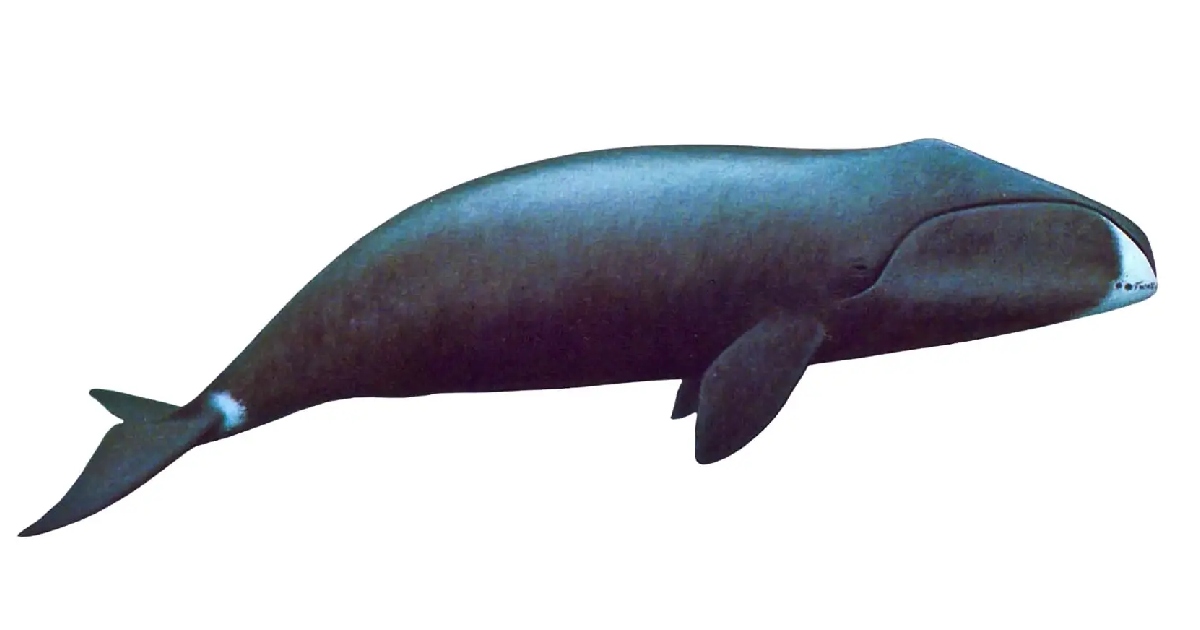
- Size: Up to 60 feet (18 meters), up to 100 metric tonnes (110 US tons)
- Scientific Name: Balaena mysticetus
- Key Feature: Massive skull and thick blubber
Bowhead whales are among the longest-living marine mammals, with some individuals living over 200 years. They can grow up to 60 feet in length and weigh as much as 100 metric tonnes. Bowheads have a massive skull that they use to break through Arctic ice and a thick layer of blubber to insulate against freezing temperatures. Their baleen plates are the longest of any whale species, used to filter small organisms from the water.
These baleen whales are primarily found in the Arctic and sub-Arctic regions, including the Bering, Beaufort, and Chukchi seas. Bowhead whales were heavily targeted by commercial whalers, particularly in the 19th and early 20th centuries, leading to significant population declines. Conservation efforts have helped their numbers rebound, but they remain protected and closely monitored.
Conclusion
The whale species in the world are true giants of the ocean, each with unique adaptations that allow them to thrive in their respective environments. From the immense blue whale, the biggest whale and the loudest animal on Earth, to the deep-diving sperm whale, these marine mammals continue to captivate and inspire us. Understanding and protecting these magnificent creatures is crucial, as they play vital roles in maintaining the health and balance of marine ecosystems.
Whales like the blue whale and the fin whale showcase the diversity and grandeur of baleen whales, while toothed whales like the sperm whale and orca highlight the adaptability and intelligence of these ocean giants. Conservation efforts, such as those targeting the critically endangered North Atlantic right whale, are essential to ensure these species can continue to thrive for generations to come.
The history of whaling, including the dark days of the South Georgia whaling station, reminds us of the importance of sustainable practices and the need to protect these incredible creatures. As we learn more about whales and their vital role in the marine environment, it becomes clearer to us why we should protect them. Through conservation efforts and sustainable practices, we can ensure that these giants continue to thrive for generations to come.
Frequently Asked Questions (FAQs)
What is the largest whale species?
The largest whale species is the blue whale (Balaenoptera musculus). These marine giants can reach lengths of up to 100 feet (30 meters) and weigh as much as 100 tons (90 metric tonnes). Blue whales are the largest animals ever known to have existed on Earth, surpassing even the largest dinosaurs in terms of mass.
What is bigger than the blue whale?
In 2023, paleontologists estimated that the extinct whale Perucetus colossus, discovered in Peru, may have outweighed the blue whale. This massive whale species is thought to have had a mass ranging from 85 to 340 tons (94–375 short tons; 84–335 long tons). Perucetus colossus potentially exceeds the heaviest blue whale recorded, making it one of the largest animals to have ever existed.
Which is bigger, the Humpback or the blue whale?
The blue whale is significantly larger than the humpback whale. While humpback whales (Megaptera novaeangliae) can reach lengths of up to 50 feet (15 meters) and weigh around 40 tons (36 metric tonnes), blue whales can grow up to 100 feet (30 meters) long and weigh as much as 100 tons (90 metric tonnes). Blue whales are the largest animals on Earth, making them much bigger than humpback whales.
What is the rarest and largest whale species in the world?
The blue whale (Balaenoptera musculus) is both the largest and one of the rarest whale species. Despite being the largest animal on Earth, blue whale populations were severely reduced due to extensive whaling in the 20th century. Conservation efforts are ongoing to protect and recover their numbers, but they remain endangered and are a rare sight in the world’s oceans.
What is the biggest whale that ever lived on Earth?
The biggest whale ever to have lived on Earth is the blue whale (*Balaenoptera musculus*). These colossal creatures can reach lengths of up to 100 feet (30 meters) and weigh as much as 100 tons (90 metric tonnes). Their immense size surpasses that of any other known animal, living or extinct, making the blue whale the largest animal to have ever existed.

